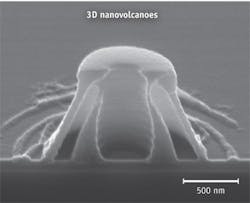By shining light of various colors through a nanoscale synthetic-polymer sphere, researchers have fashioned volcano-shaped nanostructures able to store precise amounts of other materials. Thus, the structures hold promise for drug delivery.
To create the volcano-shaped nanostructures, North Carolina State University (Raleigh, NC) researchers first placed the transparent polymer balls onto a flat thin film and then shined ultraviolet light through the spheres to create a pattern on the film. Because the film is made of a photoreactive material, it was chemically changed wherever the light hit it. The researchers then submerged the thin film in a liquid solution that washed away the light-exposed sections—revealing nanoscale hollow mounds in the material that remained.
The researchers have discovered that they can control the size of the volcanoes' cavities by changing the diameter of the nanoparticle spheres, or by changing the wavelength—or color—of light used, according to doctoral student Xu Zhang, lead author of a paper describing the work.1 Adjusting the core size would allow control over how much of a drug could be stored, while controlling the opening at the top could enable regulation of the drug's release. The team is now working to understand how such adjustments could be functionalized for drug delivery.
"It's exciting to take our understanding of how light scatters by particles and apply it to nanolithography in order to come up with something that could actually help people," says assistant professor Chih-Hao Chang, a co-author of the paper.
1. X. Zhang, J. Elek, and C.H. Chyang, ACS Nano, doi:10.1021/nn402637a (2013).

